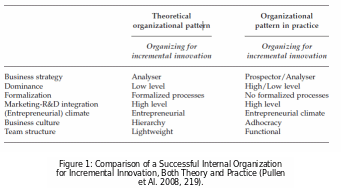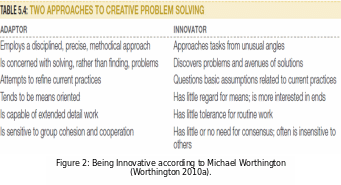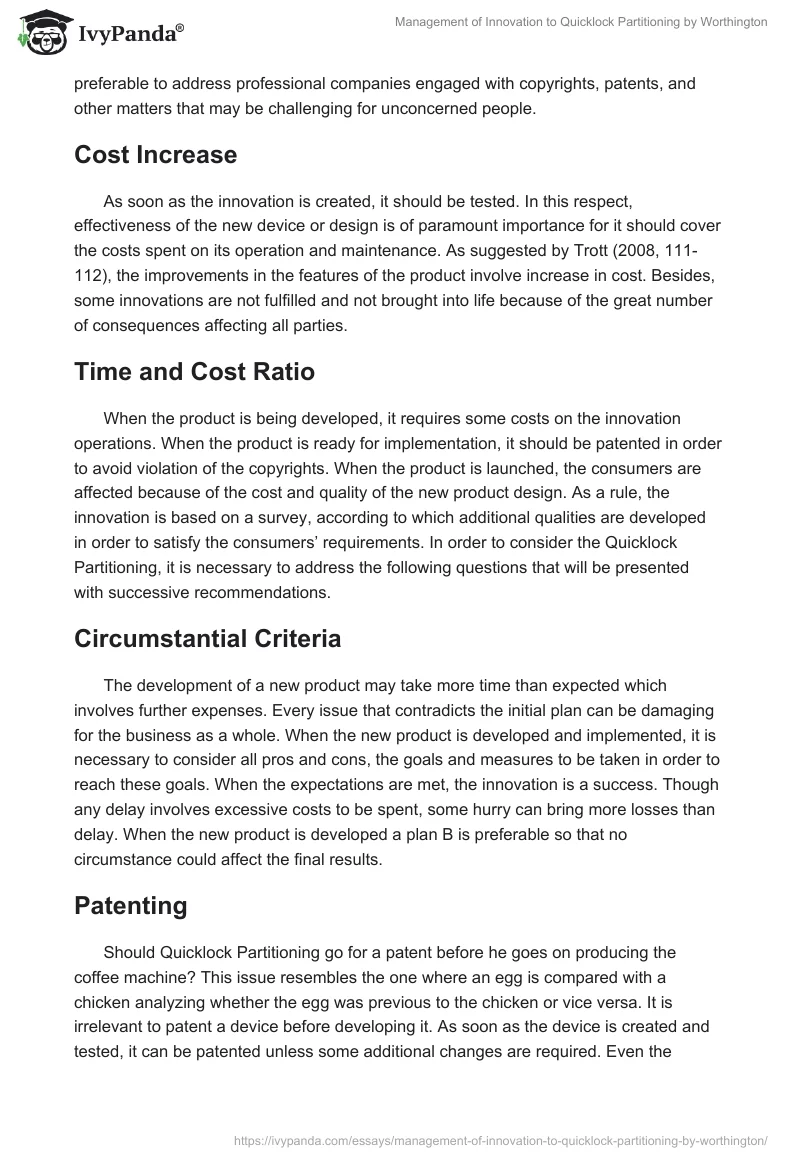Introduction to the Implementation of Innovation
Innovations make our life easier and more convenient. Some mechanisms used nowadays are regarded as an integral part of the day-to-day life; however, they have not been introduced and positioned as those. The first steps are always difficult to take because of different obstacles and a great number of measures to be taken in order to protect one’s business. As soon as all formal requirements are met, the innovation starts working and brings some profit. Creative approach and legal issues on patent (lodging and protecting) take some time and require keeping secret and professional assistance to cope with time-consuming matters (Worthington 2010a; Worthington 2010b ).
Managing Innovation and Operations Management
Future Steps for Development of Quicklock
As technologies and new businesses are commonly associated with innovations (Geneste 2010), it is necessary to regard the concept of innovations and their implementation into business as an integral part of a technologically-advanced business, especially when its owner is its main innovator as in the case with Quicklock Partitioning and its owner Michael Worthington. The need for creativity and efficiency has also been faced which allows an assumption to be made concerning the necessity of introducing innovation including the use of internal and external drivers for implementation of innovation (Manley et al. 2008, 5). Moreover, the new technologies should be registered before used in order to avoid legal debate in the court because of violation of somebody’s rights. As copyright issues are of disputable nature, it is preferable to address professional companies engaged with copyrights, patents, and other matters that may be challenging for unconcerned people.
Cost Increase
As soon as the innovation is created, it should be tested. In this respect, effectiveness of the new device or design is of paramount importance for it should cover the costs spent on its operation and maintenance. As suggested by Trott (2008, 111-112), the improvements in the features of the product involve increase in cost. Besides, some innovations are not fulfilled and not brought into life because of the great number of consequences affecting all parties.
Time and Cost Ratio
When the product is being developed, it requires some costs on the innovation operations. When the product is ready for implementation, it should be patented in order to avoid violation of the copyrights. When the product is launched, the consumers are affected because of the cost and quality of the new product design. As a rule, the innovation is based on a survey, according to which additional qualities are developed in order to satisfy the consumers’ requirements. In order to consider the Quicklock Partitioning, it is necessary to address the following questions that will be presented with successive recommendations.
Circumstantial Criteria
The development of a new product may take more time than expected which involves further expenses. Every issue that contradicts the initial plan can be damaging for the business as a whole. When the new product is developed and implemented, it is necessary to consider all pros and cons, the goals and measures to be taken in order to reach these goals. When the expectations are met, the innovation is a success. Though any delay involves excessive costs to be spent, some hurry can bring more losses than delay. When the new product is developed a plan B is preferable so that no circumstance could affect the final results.
Patenting
Should Quicklock Partitioning go for a patent before he goes on producing the coffee machine? This issue resembles the one where an egg is compared with a chicken analyzing whether the egg was previous to the chicken or vice versa. It is irrelevant to patent a device before developing it. As soon as the device is created and tested, it can be patented unless some additional changes are required. Even the presentation by Worthington (2010a) suggests the list relevant to the innovation where the innovation goes first followed by the “‘ah hah’ moment!”, and finally, the concept of “patent (lodging and protecting it)” is regarded. The effectiveness of innovation is the subject of another discussion, which means that patenting should follow the innovation itself. When the innovation is tested, evaluated, approved and considered effective and appropriate, it can be patented. However, keeping secret is important until the task is finished.
Organisational Structure
Another issue that should be touched upon is the organisational structure that should contribute to the overall success of the venture. When the company is organised in accordance with an appropriate structure to meet all the company’s requirements, it is easier to choose a corresponding type of management to be incorporated to run the business. The new product development should take place in the well-organised manner in order not to miss a detail. In the course of managing a certain business or innovation or both, it is necessary to establish a strategy and follow it. As you can see, planning is of primary importance because it includes planning of financial issues as well as of organisational, strategic, and change management.
Partners and Suppliers
Partnership and cooperation can benefit greatly the further development of the Quicklock as thoroughly chosen partners and suppliers present an important stage of development of any business. If an owner wants his/her business to be profitable, it should be developed; as soon as the “Select the right partners and suppliers – creatively structure deals for optimum mutual gain” (Open Innovation 2007, 2). As partnership is an element which can bring the business a success or be a total failure.
Coffee Making Equipment
The coffee making equipment is the area which presents the innovation. As the new design of the device is aimed at making the operation of the apparatus and production more organised, it is necessary to implement innovations related to the design which facilitates the production process. If the coffee making equipment is not of high priority, it can be separated as an individual business “with a separate management structure” (Worthington 2010c).
Coffee Business
The coffee business is by all means profitable and can run as a separate unit, whereas the implementation of the innovation is a challenging task for such an adventurist as Michael Worthington who presents his vision of an innovator in the presentation (see Figure 2). The comparison of the implementation of the innovation in practise opposed to theoretical approach can be viewed in Figure 1.


Machine Design
The next question offers the owner to expand or go for the coffee machine or focus on Quicklock Partitioning. The answer on this question can be easily found in the presentation made by the owner of the business and innovator, Michael Worthington. The author suggests different options and explains that the coffee business is profitable:
The coffee business is purely entrepreneurial. A gap in the market I believe can be exploited quickly, easily and above all with very little capital investment and therefore quite low risk (Worthington 2010c).
As you can see, the owner is little concerned about the coffee business itself; the main difficulty is related to the coffee machine which is of great value because of its innovative design.
Experience of other Innovations
The company should take into account the business with all its experience and opportunities. It seems impossible to create something new without being aware of the previous and already existing and implemented innovations. Thus, Trott (2008, 84-85) suggests that the experience of innovation should be regarded while developing and implementing innovation. When all opportunities are used, the success is more likely to be attained than without knowing the area and circumstances suggested.
Cost Saving Innovation
The concept faced while implementing an innovation is the cost and quality ratio. “Cost saving innovations can be easy for small firms to implement if they can demonstrate a low risk-profile” (Manley et al. 2008, 6). As well as the owner of the business is concerned about the risk that is involved into every venture (Worthington 2010b). Taking into account the affected parties, the costs of the innovation, and possible risks, the owner should bear responsibility with regard to the necessity of implementation of this innovation.
Conclusion
The innovation is a complicated issue that should be created and implemented into the already existing conditions. When the management and organisational structure is chosen appropriately, the balance between the costs, quality, and necessary measures can be easily reached. As soon as the plan is developed, the team can work on the innovation itself regarding its effectiveness and relevance to the facilitating of the production process. The new design may involve additional costs which do not mean that consumers are ready to pay for some innovation and its design. Consequently, the research is of primary importance when planning the new design or some other changes in the product or mechanism. All changes will result in the cost increase; the innovators should consider the cost and quality ratio in order to avoid excessive expenditures in future.
Bibliography
- Geneste, L. 2010. Session 5: Managing Innovation within Firms (Chpt. 3) and Innovation and Operations Management (Chpt. 4 – first half).
- Manley, K., J. Marceau, R. L. Parker, and J. H. Matthews. 2008. Twenty-Second ANZAM Conference, Managing in the Pacific Century 2008: The potential contribution of small firms to innovation in the built environment. Auckland, New Zealand: Australian Cooperative Research Centre.
- Open Innovation – Opportunities, Models and Methods. 2007. CoDev 2007. Google Scholar.
- Pullen, A., P. Weerd-Nederhof, A. Groen, M. Song, and O. Fisscher. 2009. Successful patterns of internal SME characteristics leading to high overall innovation performance. Creativity and Innovation Management 18 (3): 209-223.
- Trott, P. 2008. Innovation management and new product development. 4th ed. Essex: Pearson Education Limited.
- Worthington, M. 2010a. Entrepreneurs and Enterprises: Showcasing innovative and inspirational success. PowerPoint slides.
- 2010b. Interview on Michael Worthington’s Quicklock Partitioning. Tape recording. Curtin University of Technology, Venue 408.1019.
- 2010c. Questions for the CEO, Michael Worthington. Curtin University of Technology.


